
Which are the major rivers of the world? What are the features and routes reversed by these majestic river systems? Which is the longest river in the world? What is the largest river in the world? Read further to learn the major river systems of the world listed according to continents.
A river is a naturally flowing freshwater watercourse that runs towards an ocean, sea, lake, or another river.
The world is home to numerous major rivers that play crucial roles in the ecosystems, economies, and cultures of the regions they flow through.
These rivers have shaped landscapes, supported civilizations, and influenced the development of societies throughout history. They continue to play significant roles in regional environments and economies.
Major Rivers of the World
Flowing bodies of freshwater that empty into seas, oceans, lakes, and reservoirs are referred to as rivers.
Major rivers of the world are crucial for providing drinking water, irrigation, transportation, and hydroelectric power generation, as well as for a variety of leisure activities like swimming and boating. The whole continents of the world are traversed by numerous rivers and their tributaries.
Water covers around 70% of the Earth’s surface and can be found in rivers, lakes, streams, and seas. Here are some of the major rivers of the world, listed by continent.
Africa
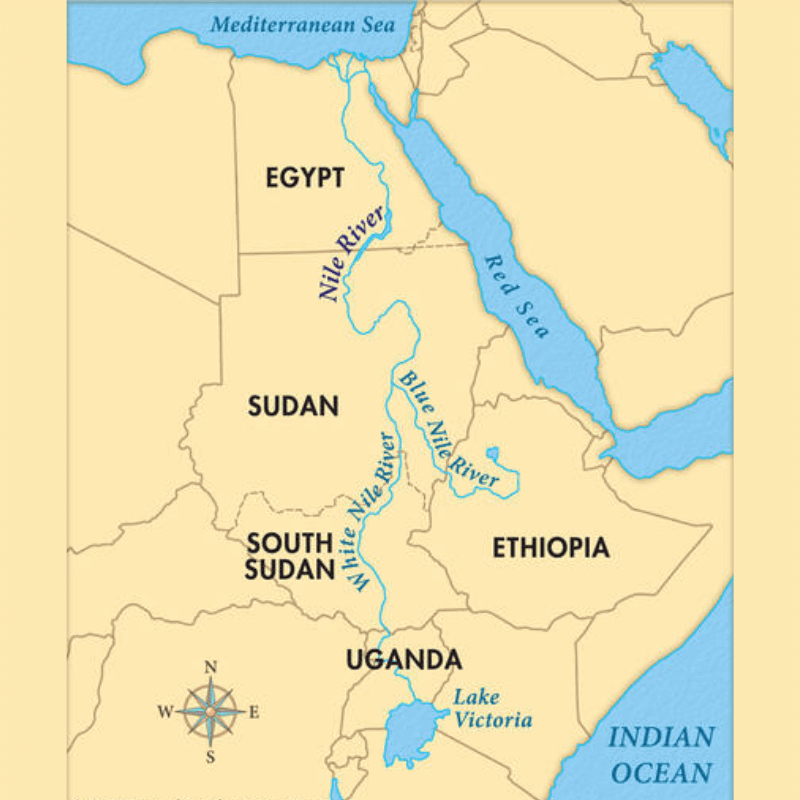
River Nile
Considered to be the longest river in the world. The length of the Nile River is roughly 6650 kilometers. Lake Victoria is assumed to be the river’s origin. The river’s course passes through Egypt, Uganda, Ethiopia, Kenya, Tanzania, Rwanda, the Democratic Republic of the Congo, Eritrea, Burundi, Sudan, and South Sudan. The Blue and White Niles are the river’s two tributaries.
River Congo
The only river to cross the equator twice is the Congo River. It is originally known as the Zaire River. It has a length of 4700 Km. It travels in a curving pattern across the continent of Africa. With some sections reaching depths of over 700 feet, it is also the deepest river in the entire globe.
Orange River
The Orange River is the longest in South Africa. It starts in the Drakensberg in neighboring Lesotho, where it is also known as the Senqu River. It travels across South Africa before entering the Atlantic Ocean. The Orange River is a component of the border between Lesotho and South Africa as well as between Namibia and South Africa.
From the river’s source and the Atlantic Ocean, it travels 1,365 miles. The river was known as Gariep by the first residents, and Groote Rivier by the Dutch. Nonetheless, Colonel Robert Gordon gave it the name Orange River in 1779 in recognition of William V of Orange. Via the Orange River Project, the Orange River supports mining, manufacturing, and agriculture. The alluvial deposit on the river was where the first diamond in South Africa was found.
Limpopo River
The Limpopo River originates in southern Africa’s central regions. It extends to a length of about 1,087 miles before flowing eastward toward the Indian Ocean. It has a 415,000-square-kilometre drainage basin. It is the Limpopo River that divides South Africa from Botswana and Zimbabwe.
The river starts at the confluence of its two tributaries, the Crocodile and Marico Rivers; its principal tributary in Botswana is the Notwane River. The Limpopo Basin is also home to numerous mining operations. Nonetheless, flooding has resulted in losses and damages.
Niger River
Flows through West Africa, passing through countries like Nigeria, Niger, Mali, and Guinea discharging through a massive delta, known as the Oil Rivers, into the Gulf of Guinea. The Niger River is the principal river of western Africa, extending over 2,500 miles (about 4,180 km). The Niger is the third longest river in Africa, exceeded only by the Nile and the Congo Rivers (also known as the Zaïre River). Its main tributary is the Benue River.
Zambezi River
The “Big River” sustains the lives of many iconic African species, including elephants, buffalo, hippos, antelope, and crocodiles, as well as the people who live between its modest source in the Zambian highlands and the Indian Ocean. It passes through parts of Angola, Namibia, Botswana, and Zimbabwe.
As it moves eastward, the Zambezi gains momentum and supplies plenty of electricity to many of the communities in its basin. Zambia and Zimbabwe receive power from the Kariba Dam, while Mozambique and South Africa are lit up by the Cahora Bassa Dam. These two hydroelectric plants are among the biggest in Africa. Victoria Falls is undoubtedly Zambezi’s most noteworthy feature.
Asia
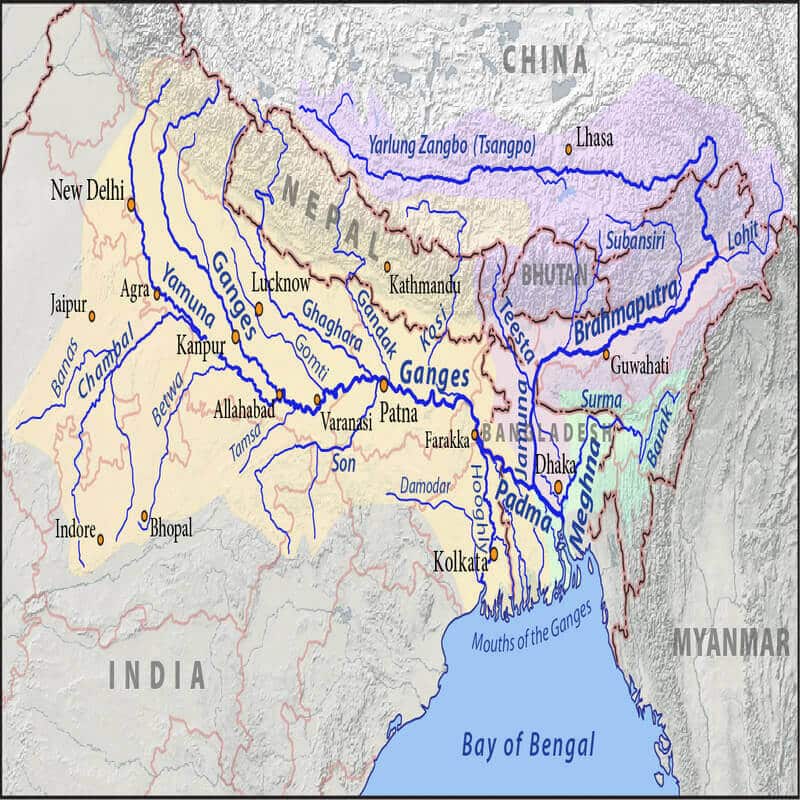
Ganges river
Bangladesh and India are traversed by the Ganges River. The river is 2510 kilometers long and a notable landmark, but it is better known for its profound religious importance.
The Ganges is regarded as the most revered body of water in the world in Hindu culture and religion. In mythology, the river represents the goddess Ganga, who was the offspring of the mountain deity Himalaya.
Brahmaputra River
China, India, and Bangladesh are all countries that the Brahmaputra River passes through over a distance of 2,391 miles (3,848 km). It runs towards the east through the Tibet Autonomous Region of China from its source in the mountains then into India. The stream drains into the Bay of Bengal from that location. It travels across Bangladesh and Assam during that time.
Also read: Transboundary rivers of India
Indus River
Next on the list is the Indus River, which flows across China, India, and Pakistan for a distance of 2,243 miles (3,610 km). It has twenty significant tributaries and is the largest and most important river in Pakistan. It originates in the Tibetan plateau, close to Lake Mansarovar and the Himalayas, flows through the Indian provinces of Jammu and Kashmir, and then across all of Pakistan before emptying into the Arabian Sea, a branch of the Indian Ocean.
Also Read: Indus Valley Civilization, Indus River and Tributaries, Major River systems in India
Yellow River
This huge river, which has a length of 5464 Km also known as the Huang He, is named after the color of its water. The color is caused by massive amounts of loose debris. Its basin is considered the birthplace of ancient Chinese civilization. It has enormous symbolic and practical significance for the country.
Mekong River
It stretches about 5,000 kilometers from its source on the Tibetan Plateau to the Mekong Delta. The longest river in Southeast Asia and the seventh longest in all of Asia is this transboundary river. The river, which is known by several names, flows through six Asian nations: China, Vietnam, Laos, Myanmar, Thailand, and Cambodia.
65 million people are living in the Mekong Basin, 80 percent of whom reside in the lower basin. With over 20,000 plants and 800 different species of fish, the river is likewise incredibly diverse.
Irrawaddy River
Myanmar is traversed by the Irrawaddy River, which runs from north to south. At a length of 1,348 miles, it is both the longest river in the nation and the most significant body of water for commerce. The Irrawaddy River rises at the meeting of the Rivers N’mal and Mali. It travels southward before draining into the Andean Sea through the Irrawaddy Delta. A region of about 255,000 square kilometers is drained by the river.
The Irrawaddy River is home to a variety of creatures, including 43 different species of fish. The river provides water for rice irrigation and is a significant means of export and import transit. Notwithstanding the concern expressed by environmentalists, work is still being done along the river to build seven hydroelectric dams.
Salween River
A 1,491-mile-long river called the Salween originates in the Tibetan Plateau. It enters the Andaman Sea in Southeast Asia after passing through three nations. It drains a 320,000-square-kilometre watershed that is spread throughout China, Myanmar, and Thailand.
Almost 7 million people live along the Salween, one of the longest free-flowing rivers in the world, and are spread across 13 different ethnic groups. Moreover, the river is home to 25% of all animal species in the world, as well as 140 fish species and 7000 plant species. UNESCO rates the upper section of the river, which is in China, as the most biodiverse temperate ecosystem on Earth.
Yangtze River
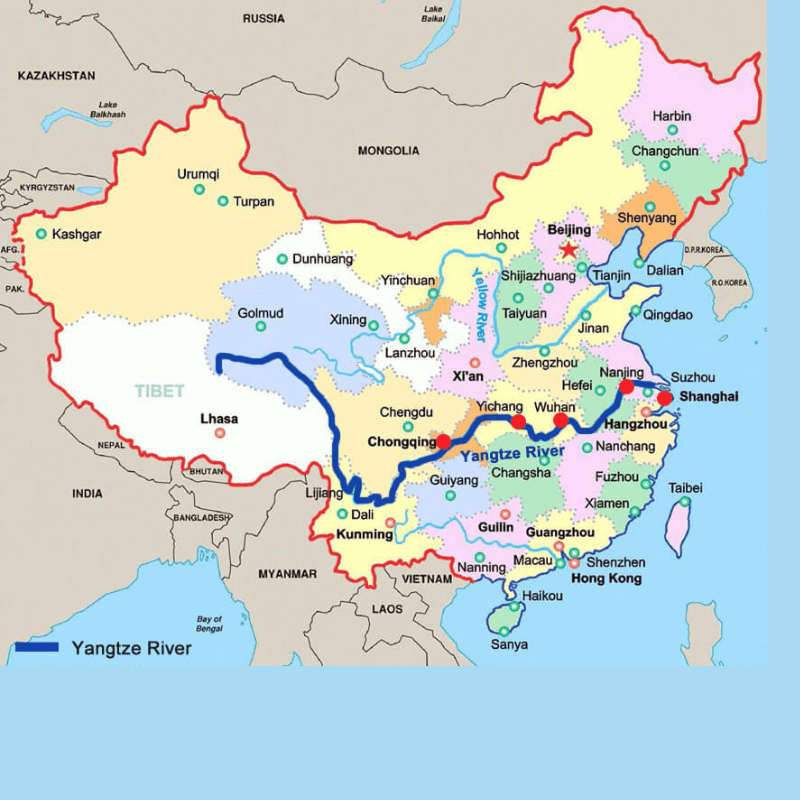
The Yangtze River is the third-longest river in the world and the longest river in the world to run entirely within one nation. It has a length of 6300 Km. Moreover, it is Asia’s longest river. One-third of China’s population is residing in the Yangtze River basin. The Chinese government has long believed that the river’s source is the Tuotuo tributary in the Tanggula Mountains.
Recently it is indicated that the headwaters of the Dam Qu tributary are located on Jari Hill, which is where the Yangtze River’s source lies. The Yangtze River, which drains into the East China Sea at Shanghai, is formed when these and other tributaries come together.
Yenisei River
The Yenisei River originates in Mongolia and travels north before emptying into the Kara Sea in the Arctic Ocean via the Yenisei Gulf. Along the way, it drains a sizable portion of Siberia. The Yenisei begins in the Russian city of Kryzyl at the meeting of its headstreams, By-Khem (rising in the Eastern Sayan Mountains) and Ka-Khem (rising in Mongolia).
It then runs for 3,487 kilometers until finally draining into the Kara Sea. One of the main Yenisei headwater tributaries, the Angara River drains Lake Baikal. It enters the Yenisei near Strelka in Russia after leaving Lake Baikal.
River Irtysh
The main tributary of the Ob River, the Irtysh River, has its origins in the glaciers of the Altai mountains in the Chinese region of Xinjiang, which is close to Mongolia. It eventually meets the Ob near Khanty-Mansiysk, western Siberia, Russia, and flows northwest into Kazakhstan before emptying into the Arctic Ocean.
The river’s whole course spans around 4,248 km. Along with its banks, there are several significant cities in China, Kazakhstan, and Russia. The river is a crucial conduit for the movement of people and goods throughout the nations through which it flows.
Ural River
The Ural River is a 2,428 km long river that flows through Russia and Kazakhstan along the continental divide between Europe and Asia. It is also known as the Zhayyq River in the local Kazakh language. The Caspian Sea, the most enormous inland sea in the world and located between Europe and Asia, is where the river drains after its source in Russia’s Ural Mountains near Mount Kruglaya.
The digitate delta, or tree-like structure, of the Ural River, which is visible as it enters the Caspian Sea, is a notable characteristic of the river. The words “Europe” and “Asia” are engraved into permanent monuments that are placed on either side of the Ural River bridge in Orenburg, Russia.
Lena River
The Lena River spans the entirety of Russia’s boundaries and is 2,668 kilometers long. It can be found in the north, where there is a wealth of wildlife and natural resources, including gold. The river originates in the Baikal range, just to the east of the actual Baikal Lake, and travels primarily through the Russian Republic of Sakha before finally joining the Yenisei River and making a vast arc up to the Laptev Sea, which is a part of the Arctic Ocean, where it empties.
River Amur
The Heilong Jiang, commonly known as the Amur River, is the tenth-longest river in the world. It forms the border between northeastern China and Russia. It has a length of 4480 Km. The word Amur is thought to have originated from a term meaning “water”. The Chinese word Heilong Jiang translates to “black dragon river.”
Ob-Irtysh
The Ob-Irtysh also referred to as the Ob River, is one of the three major Siberian rivers, together with the Yenisei and the Lena. It starts in the Altas Mountains and empties into the Arctic Ocean. It has a length of 5410 Km.
River Euphrates

The Euphrates River, which spans over 2,800 km, is regarded as Western Asia’s longest river. The river rises in the Armenian Highlands in southeast Turkey. It flows through Syria and Iraq to meet the Tigris River and eventually empties into the Persian Gulf.
River Tigris
It was one of the primary water sources that helped Mesopotamia and other ancient cultures develop. The Tigris River, which flows 1,750 km from its source in the Armenian Highlands to its mouth in the Persian Gulf, is Western Asia’s second-largest river after the Euphrates River.
The Tigris River drains an area of around 375,000 square kilometers and passes through Turkey, Syria, and Iraq (including Iran). Nearly the whole length, the Tigris River and Euphrates River are parallel.
Europe

Danube River
It is one of the s most important shipping lanes in Europe. It plays a key factor in the settlement patterns and political development of Central and South-Eastern Europe. It originates at the meeting of the Brigach and Breg rivers, close to the German town of Donaueschingen, in the Black Forest region of Germany.
It flows for 2,850 kilometers. Germany, Austria, Hungary, Serbia, Bulgaria, Croatia, Slovakia, Moldova, Ukraine, and Romania are among the ten European countries that the river flows through. Ultimately, the Danube River empties into the Black Sea through the Danube Delta.
It is referred to as Donau in Germany and Austria; known as Dunaj in Slovakia and Ukraine, Dunărea in Romania, Dunav in Croatia, Serbia, and Bulgaria, and Duna in Hungary. Many cultural artifacts, including Greek myths, Romanian melodies, and even contemporary novels, memorialize its importance.
River Oder
The Oder River is the second-longest river in Poland, measuring roughly 840 km. Its source is in the rocky highlands of the eastern Czech Republic. It runs through Poland’s western region before forming a boundary with Germany. The Peene, Wina, and Dziwna branches all drain into the Baltic Sea, while the river’s main branch empties into the Szczecin Lagoon.
Dnieper River
The Dnieper River is the fourth-longest in Europe with a length of around 2,200 km. It comes from the Valdai Hills, which are close to the city of Smolensk in Russia. More than 32,000 tributaries of the Dnieper River are thought to exist. Berezina, Bilozerka, Drut, Desna, Prypiat, Sozh, Myareya, Samara, Sula, and Vyazma are a few of its tributaries.
River Volga
The Volga River is the main river in western Russia. It extends 3,530 kilometers from its source in the Valdai Hills to the Caspian Sea, the biggest inland body of water in the world. It encompasses a significant portion of the Volga area. A little more than half of Russia’s population resides in the Volga River Basin.
Four of the ten largest cities in Russia are located along the river’s full course. One of the greatest rivers in the world due to its historical, cultural, and economic significance. In the past, the Eurasian Civilization came together near the Volga River. It also has some of the biggest reservoirs in the world and provides a significant portion of the direct and indirect livelihood for millions of people.
Elbe River
The Elbe River is 1,112 kilometers long. It has its beginnings in the southern Krkonose Mountains, which are close to the border between Poland and the Czech Republic. Following Bohemia in the northwest of the Czech Republic, it runs past Germany’s eastern border and into the North Sea close to the town of Cuxhaven. Saale, Mulde, Ohre, Vltava, Schwarze Elster, Havel, and Alster are a few of the important Elbe River tributaries.
River Rhine
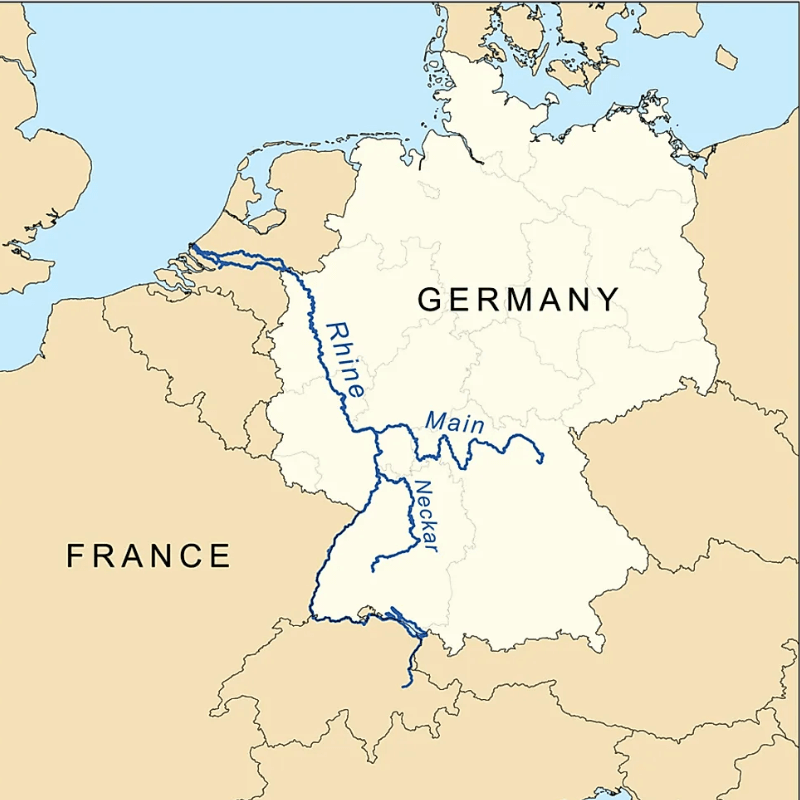
With a length of almost 1,230 kilometers from its source in Switzerland to its mouth on the North Sea in the Netherlands, the Rhine River is the eleventh-longest in Europe. This transboundary river travels through six nations—Switzerland, Germany, Austria, Liechtenstein, Germany, and the Netherlands. It drains an area of around 185,000 square kilometers.
The Rhine Basin also drains sections of France, Italy, and Belgium. One of Europe’s most significant rivers in terms of history, culture, and economy is the Rhine. Over 20% of the world’s chemical industry is manufactured near the river, which helps industrial transportation and output. The Rhine and the Danube together formed the northern inland border of the Roman Empire.
Rhone River
The Rhone River begins in the Rhone glacier of the Swiss mountains. It has a length of around 813 kilometers. This swiftly moving river enters Lake Geneva at its eastern end before running through the southeast of France on its way south. The Rhone River splits into the Big Rhone and Little Rhone near the French city of Arles before emptying into the Mediterranean Sea.
Thames River
The River Thames is a 346 km river that originates at Thames’s head in the Cotswold Hills in the county of Gloucestershire. It flows across southern England. After the River Severn, it is the second-longest river in the United Kingdom and the longest in England. The river runs into the North Sea via the Thames Estuary after passing through several well-known cities, including London, Reading, Hendley-on-Thomas, Windsor, and Oxford, where it is also known as the Isis River.
Don River
The Don River is the fifth-longest in Europe with a length of roughly 1,870 kilometres. Then, when it approaches the Volga River, it runs in a southeasterly direction until abruptly turning west to enter the Gulf of Taganrog in the Sea of Azov. Chir, Seversky Donets, Chyornaya Kalitva, Krasivaya Mecha, Khopyor, and Medveditsa are a few of the Don River’s tributaries. The Don River and the Volga River are connected by the Lenin Volga-Don Shipping Canal.
North America
River Mississippi
The Mississippi, Missouri, and Jefferson rivers combine to form the world’s fourth-longest river system. It has a length of 6275 Km. The river system drains 31 US states as well as two Canadian provinces.
The Mississippi River runs into the Gulf of Mexico from northern Minnesota. Lake Itasca is regarded to be its source. We get the Mississippi-Missouri-Jefferson River system when we regard the Jefferson River as the Mississippi River’s farthest source.
Also Read: Major Landforms – Mountains, Plateaus, and Plains: Learn faster – ClearIAS
Saint Lawrence River
Its discharge originates in Lake Ontario and empties into the Atlantic Ocean near the Southeast coast of Canada’s main continent. The St. Lawrence Seaway, which stretches for approximately 4,000 kilometers (or 2,500 miles), includes the river, which is 1,197 kilometers (744 miles) long. The river was once a basin filled with glaciers that grew larger as the ice flowed away.
Mackenzie River
The Mackenzie River system is found in North America. It is also the biggest and longest river basin in Canada. From its headwaters in the Finlay River to its drainage into the Beaufort Sea in the Arctic Ocean, the Mackenzie River system travels 4,241 kilometers. Together, the Mackenzie and its tributaries drain a region that makes up nearly 20% of all of Canada’s land.
Many of the Mackenzie River’s tributaries extend into neighboring Canadian provinces including British Columbia, Saskatchewan, Alberta, and Yukon, even though the Mackenzie River itself fully runs within the Northwest Territories of Canada. The Peace, Athabasca, and Liard Rivers are a few of the Mackenzie River’s most significant tributaries. The Lake Athabasca, Great Slave, and Great Bear Lakes are only a few of the lakes that are significant components of the Mackenzie River system.
Missouri River
A major tributary of the Mississippi River in the United States.
Colorado River
Flows through the southwestern United States and northern Mexico, known for the Grand Canyon.
South America
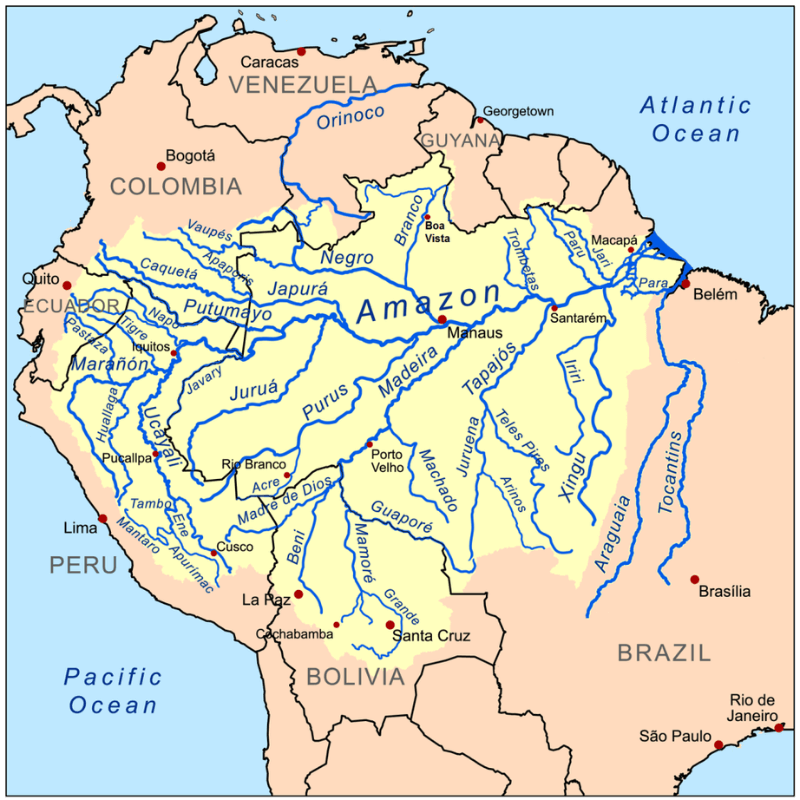
Amazon River
In terms of total water flow volume, the Amazon River is without a doubt the largest in the world. It has a length of 6575 Km. Its claims to be the second-longest river in the world, however, is widely contested because Egypt’s Nile River has long held the title. The debate on the origins of the Amazon is the source of the dispute. The Cordillera Rumi Cruz is where the Amazon started, claims a 2014 study.
Parana River
One of the world’s longest rivers with a length of 4880 Km. The Parana River is found in South America. The Tupi word para the onáva, which means “like the sea,” is the source of its name.
Orinoco River
In South America, the Orinoco River passes through Colombia and Venezuela. In terms of the volume of discharge, it is ranked as the fourth-largest river in the world. Its 1,330-mile length makes it one of South America’s longest rivers.
Madeira River
One of the principal rivers of South America, the 2,100-mile-long Madeira River flows between Bolivia and Brazil. It is one of the largest and most important tributaries of the Amazon River. The Portuguese referred to it as “Madeira,” which translates to “Wood River,” but its previous name was the Cuyari River.
The Madeira is created by the confluence of the Mamore and Madre de Dios rivers. This river overflows during the rainy season, rising to a height of 50 feet and submerging the forests on its sides. From arider to more humid, its climate varies as it moves from region to region. After entering the lower plains, the Madeira River empties into the Abuna River.
Australia
Murray River
Australia’s longest river, the Murray, flows through the southeast of the nation. It travels through New South Wales, Victoria, and South Australia and is 2508 kilometers long. Almost 1.5 million homes in Australia receive their water from this river, which is also used to irrigate nearby fields.
Darling River
A major tributary of the Murray-Darling system.
Conclusion
The culture of most places of the world is heavily influenced by the larger rivers that they depend on for food and transportation. The majority of the riverside towns and villages have a robust boat industry and travel hundreds of kilometers for fishing and cargo transportation.
Some communities regard certain portions of these rivers as sacred, and only specific methods may be used to access these areas. Fish, reptiles, and huge mammals are just a few of the diverse plants and animals that may be found in the world’s rivers.
The melting of glaciers will likely be accelerated by climate change and the resulting temperature rises, which will initially increase water levels but ultimately result in decreased river discharge.
The water quality in many major rivers of the world has already deteriorated to dangerous levels as a result of heavy home, industrial, and agricultural waste pollution. Rapid economic growth and urbanization have contributed to some of this, thus pollution is expected to persist unabatedly.
Article Written By: Atheena Fathima Riyas






Leave a Reply